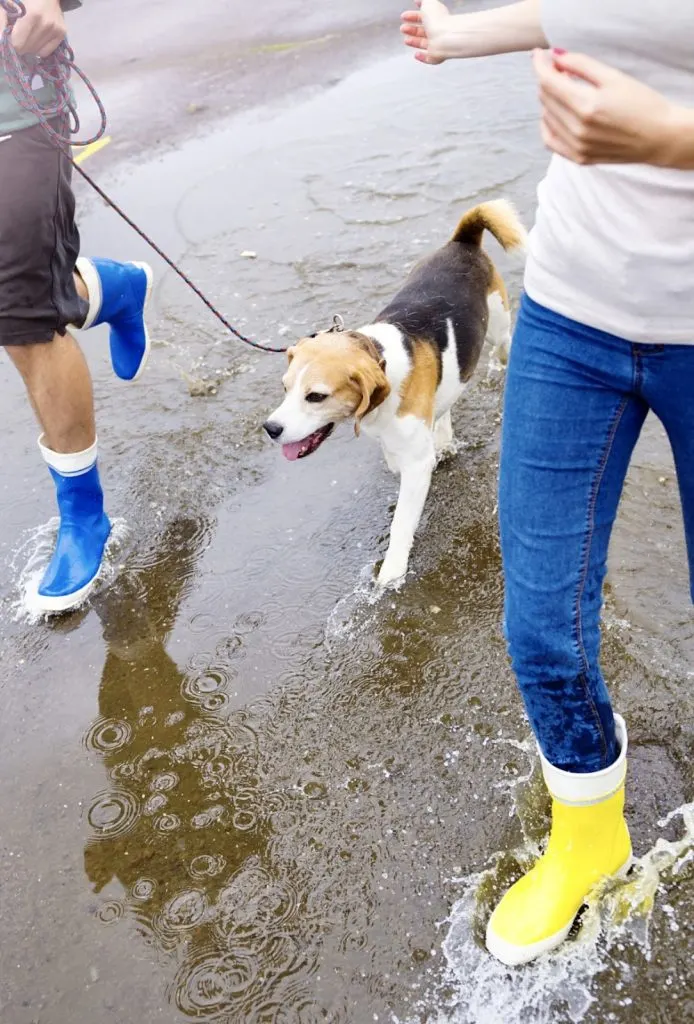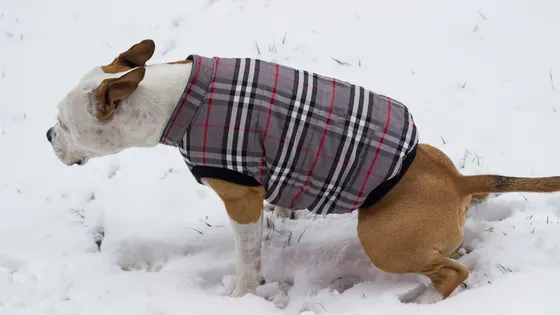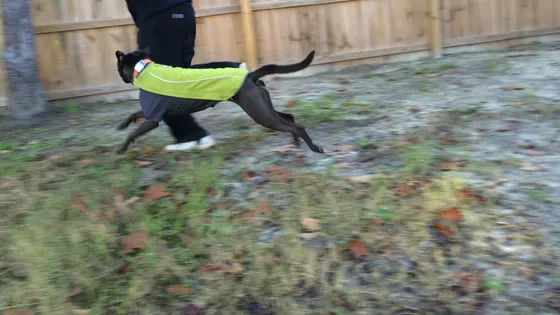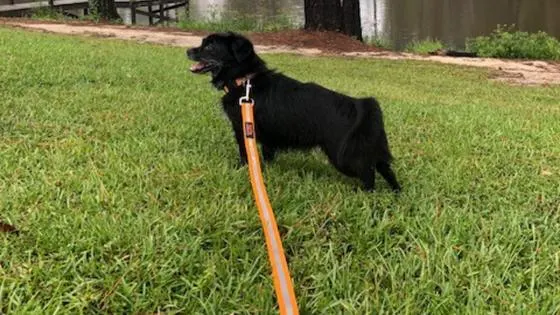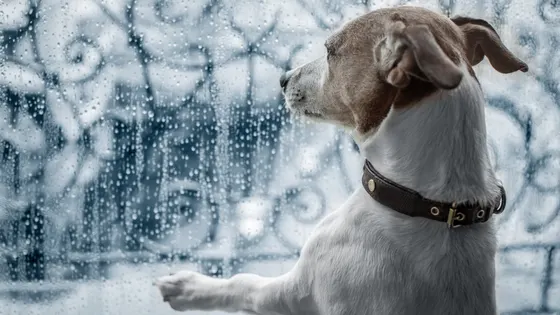During the rainy season I hear this question quite often (not so much in the summer time).
“My dog won’t pee outside when it’s raining! What should I do?”
Regardless of whether your dog refuses to potty in the rain, has accidents inside when it rains, or stoically holds it until the storm passes, we got you covered.
After all, some dogs are truly finicky about peeing in the rain, let alone going for a walk! While the behavior can be somewhat funny at first, it can also cause lots of frustration if it’s ongoing.
Especially when extended downpours make it hard for your pup to hold it and you’re stuck cleaning up messes inside.
But why won’t your dog pee in the rain in the first place?
That’s what we’ll cover in this blog post, as well as:
- How long can adult dogs & puppies hold their pee?
- Short term coping mechanisms if your dog won’t pee in the rain
- Long term strategies to teach your dog to pee outside when it’s raining
Why Won’t My Dog Pee Outside In The Rain?
First things first: There’s a variety of reasons your dog won’t pee outside when it’s raining. For example:
- Dislike of getting wet paws (not used to sensation)
- Cold sensation (vs. warm summer rain/sprinklers)
- Not a retrieving dog or water dog
- No undercoat and thin hair
- Simply not used to it
After all, dogs are creatures of habit, just like us. Most dogs have to learn that going for a quick potty break in the rain is not the worst thing in the world!
Having said that, it’s easiest to share that concept with puppies as part of their socialization to the world.
Ideally when they’re in their most impressionable phase, at 2-4 months of age.
Of course you can still teach an old dog new tricks too (YES, including peeing in the rain!), but it’s likely going to take longer.
If your rescue dog won’t pee outside in the rain, (s)he may not be used to the concept of peeing outside in the first place, especially if they’re a rescue from a puppy mill.
Those dogs are often kept in very small spaces indoors, sometimes even just wire crates stacked on top of each other.
So there’s that.
What About Snow?
The sensation of snow can be very similar to that of rain, so some dogs also won’t pee outside in the snow.
Thankfully, there’s usually a quick fix for getting your pup to potty in the snow, at least when it’s not actively snowing: grab a snow shovel and clear a patch of grass!
How Long Can A Dog Hold Their Pee?
It depends on your dog’s age, breed and size.
On average, healthy adult dogs can hold their pee for 6-8 hours.
However, they should be allowed to relieve themselves every 4-6 hours.
For puppies, add one hour to their age in months. That gives you the amount of time they can hold their pee.
For example, a 2 month old puppy can hold their pee for 3 hours.
A 5 month old puppy can hold it for 6 hours, but you really shouldn’t ask your little friend to hold it for any longer than that.
Little dogs and tiny dog breeds with smaller bladders won’t be able to hold it as long as larger dogs.
The same applies to senior dogs of all sizes – once your pup gets up there in age, they’re more likely to suffer from loss of bladder control.
Urinary tract infections can also cause accidents inside. They’re often paired with blood in the urine, so that’s a good indicator that something’s wrong and warrants a trip to your vet.
Short Term Coping Mechanisms If Your Dog Won’t Pee In The Rain (Including Specific Tools)
In order to prevent inside potties on rainy days, try to predict when your dog will have to pee (and/or poop).
Puppies will need to eliminate shortly after their meals, water breaks, playtime and naps, so it’s fairly easy to avoid accidents in young dogs.
However, you do have to watch them carefully!
For your adult dog, it pays off to know their potty habits. Generally speaking, it’s pretty common for them to have to pee within 2-3 hours of drinking water.
It’s also easier to predict your dog’s #2 needs when they have set meal times as opposed to free feeding them. That’s what it’s called when you’re keeping their bowls full at all times.
How to address potty accidents on rainy days
It’s important to promptly yet calmly address your dog’s peeing inside when it happens. Hours after the fact, your dog won’t be able to make the connection between the accident and your verbal correction.
That implies that you need to go outside into the rain (and the snow!) with your dog. So grab your rain jacket and/or an umbrella and head outside.
You can also put a rain jacket on your dog (see our list of tools below for more ideas).
On rainy days, it’s best to keep all of your and your dog’s rain paraphernalia by the front or back door. That way, you can access both quickly as needed.
It’s best not to just wait at the backdoor and expect your pup to go outside on their own.
On your way out, you can also lure your food motivated dog with a high-value treat. If they don’t care about food, try a squeaky toy!
Once they potty, offer them another treat or their favorite squeaky toy, then go right back inside. That way, they learn that the quicker they pee, the quicker they get to go back inside.
If your pup’s firm about not wanting to go outside, you can try a martingale dog training collar.
It’s particularly helpful to “convince” larger and extra large dogs to go outside. After all, you can’t just pick them up as you can smaller pups!
Tools To Help Your Dog Potty Outside When It’s Raining:
- Dog raincoat. We like Ruffwear’s Cloud Chaser Jackets. They’re easy to put on and stay on thanks to a zipper rather than a velcro closure.
- Dog boots. We like the original fleece lined Muttluks Dog Boots and also recommended the water-proof Mutt Trackers version. There’s a bit of a learning curve as far as putting them on your dog’s paws, but they’re worth it!
- Large umbrella. Oversized umbrellas that cover two people can also cover you and your pup. That way, they don’t get rained on and are somewhat more comfortable when going potty outside in the rain.
- (Martingale) collar & (waterproof) leash. For example, the Mighty Paw Martingale Dog Collar and the Mighty Paw Waterproof Dog Leash.
- Their favorite treats. High value training treats can work wonders for food motivated dogs. Check out our take on the best dog training treats here.
- Alternatively, a favorite squeaky toy. If your pup’s more into toys, try a squeaky chuck it ball. They’re easy to clean even if they get wet and muddy.
- Doggie towel when going back inside. We like the Norwex Microfiber Pet Towel because it’s ultra absorbent and made with 70% recycled materials. Bonus: It comes with a built-in antibacterial agent.
Of course you can also wait for the downpour to lessen, check the forecast, and wait for the storm to pass!
However, this can take a while if you’re in the Pacific Northwest, Great Britain or anywhere else in the world where it rains a lot…
Long Term Strategies to Help Your Dog Pee When It’s Raining
Since it’s a lot more practical if you don’t have to rely on any tools to get your dog to potty outside in the rain, you’ll have to get them used to the sensation of:
- hearing rain
- feeling rain on their back
- getting wet paws
- a wet belly (especially small dogs) and
- what wet grass feels like
Socialize Your Pup(pee) to Rain
As mentioned before, this is easiest to do as part of your socialization strategy when puppies are in their most impressionable stage, between 2-4 months of age.
During this phase, introduce your puppy to as many people, pets and environments as possible. That way, they learn that life consists of lots of variables!
Check out our Socialization Tips For Puppies & Dogs here.
By the way, rain (potty) socialization is really important for service dog puppies, too, along with getting them used to eliminating on different surfaces besides grass.
For example, concrete, sand, gravel, mulch, leaves, etc.
To socialize an adult dog to rain, you’ll have to expose them to it while making it a positive experience, just as you would with puppies.
It’s important to be patient and not start by dragging them right into a downpour. Instead, take your time and approach rainy conditions slowly.
For instance, you can start by opening a window when it’s raining and hang out next to it together with your dog. Leashing them may help guide them towards the window.
Reward your pup with verbal praise and/or hand out high value training treats for sitting or standing close to the window. Their favorite toy works too.
Once your pup has mastered the window, take it up a notch and stand by the open front-or back door when it rains. Again, reward your pup’s cooperation with praise, treats or toys.
Slowly continue exposing your dog to rainy weather, quite literally one step at a time.
To help get your dog used to the sound of rain even when it’s not actively raining:
Just click play and start handing out treats/toys!
You can also feed your dog while playing rain sounds or when it’s actively raining.
Teach Your Dog to Potty On Cue
Along with learning that rain is a normal part of doggie life, it’s also helpful to teach your dog to potty on cue.
That way, you won’t have to wait around in the rain for extended periods of time until your dog finally decides to squat or lift their leg!
To do this, praise your pup whenever they pee outside and they’ll soon make the connection between the verbal cue and their action of pottying.
You can also give them a training treat and/or a toy as an additional reward.
Bottom Line
The key to getting your dog to pee outside when it’s raining is to turn the event into a positive experience!
Reward them for peeing in the rain with verbal praise in a happy, upbeat voice.
Additionally, you can treat your food motivated dog with a yummy snack and/or a favorite toy.
Remember to be patient while you’re getting an older (rescue) dog used to the sound of rain, the sensation of rain on their body and ultimately peeing in the rain.
While you’re working towards those goals, you can use a variety of tools that help you get the job done as quickly and as pleasantly as possible.
For example, rain coats, dog boots, large umbrellas and absorbent towels.
So next time it rains, leash your pup and guide them towards the rain!

